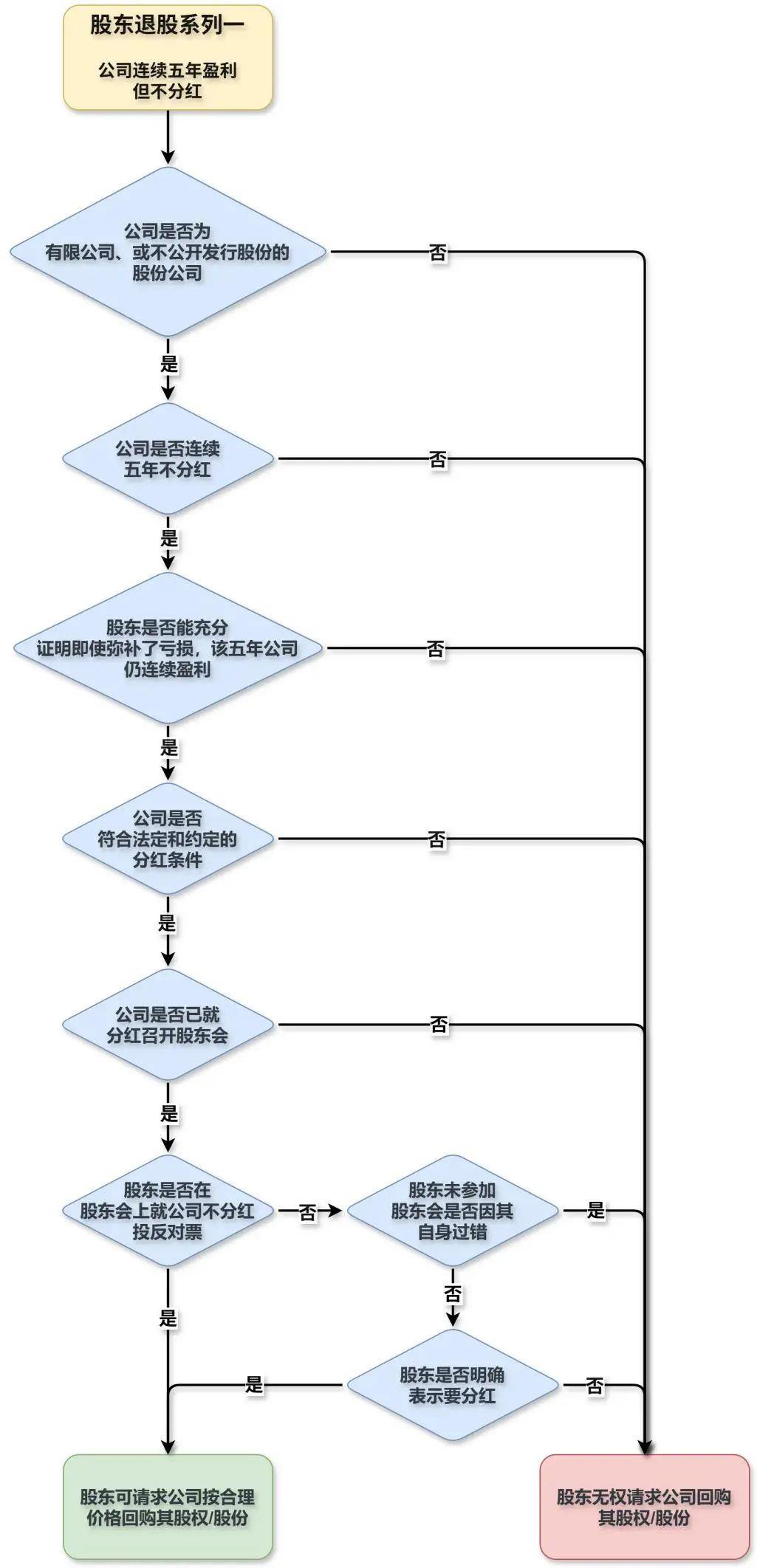How can shareholders withdraw their shares? Series One: The company has been profitable for five consecutive years without distributing dividends
2025 04/23
Dear shareholders who have invested in the company, today let's talk about a question that I often get asked: can shareholders withdraw their shares, who can they contact for withdrawal, and how to withdraw?
The so-called "withdrawal of shares" is a common term for shareholders to ask the company or other shareholders to repurchase their equity or shares. Due to the principle in the Company Law that shareholders cannot withdraw their capital contributions, it is generally not possible for shareholders to withdraw their shares of the company for various reasons when no one is willing to take over the offer; This is different from borrowing money.
Is there really nothing we can do about it?
Of course not! According to the new Company Law and judicial practice, there are currently six ways to withdraw shares, including those stipulated by law and those agreed upon by both parties; There are both those who ask the company to withdraw its shares and those who ask other shareholders to withdraw their shares; The conditions, methods, and difficulties of each withdrawal method are different.
From today on, let's talk about it one by one. This time, let's talk about the first way to withdraw from the stock: the company has been profitable for five consecutive years, but does not distribute dividends.
This is a legal requirement for companies to repurchase shareholders' equity or shares. That is to say, regardless of whether there is an agreement between the company and shareholders, as long as this condition is met, shareholders can allow the company to withdraw its shares!
1、 How is the law regulated
For limited companies, Article 89 of the new Company Law stipulates that if a company has been profitable for five consecutive years and meets the conditions for profit distribution, but the company has not distributed dividends for five consecutive years, shareholders have the right to demand that the company repurchase their equity.
For joint-stock companies, Article 161 of the new Company Law is basically the same as the above provisions, except for companies that publicly issue shares.
The core of the above two regulations is to protect the dividend rights of minority shareholders and prevent major shareholders from using their control to withhold dividends for a long time, which may harm the interests of minority shareholders.
2、 How can shareholders prove that the company has been profitable for five consecutive years
Shareholders who want to withdraw their shares must first prove that the company has indeed been profitable for five consecutive years. This is not just about words, there must be real evidence. For example, third-party evidence such as tax declaration forms and professional audit reports from tax authorities are the most convincing. If shareholders only have internal financial information of the company, the court may not recognize it.
For example, in the (2019) Shaan 0324 Min Chu 1737 case, the plaintiff shareholder failed to provide evidence of the company's profitability and was subsequently rejected by the court. The court believes that relying solely on the company's internal financial statements cannot be used as a basis for determining the company's profits, as these statements may be unilaterally altered or exaggerated by the company. So, shareholders must pay attention to retaining these key evidence, such as tax declaration forms from tax authorities, audit reports from third-party auditing agencies, etc.
Just a few more words, the company needs to be profitable for five consecutive years to meet the conditions. If it's not for five consecutive years, then it won't work; In addition, if the company has made up for previous losses and has not been profitable for five consecutive years, then it is also not acceptable.
3、 What procedures do shareholders need to follow
Shareholders cannot demand a withdrawal of shares from the company without proper legal procedures. For example, when a company holds a shareholders' meeting to discuss whether to distribute dividends, shareholders have to vote against it and go through some preliminary procedures. If shareholders do not attend the shareholders' meeting or do not vote against it, unless there are special circumstances, the court will say, "The procedure is wrong, and your claim cannot be supported
Case analysis: In the (2017) Lu 10 Min Zhong 1315 case, the plaintiff shareholder did not attend the shareholders' meeting, and as a result, the court did not support his repurchase request. The court believes that the shareholders' meeting is an important procedure for company decision-making. If shareholders have objections to the resolution, they must clearly express their opposition at the shareholders' meeting and retain relevant evidence, such as meeting minutes, voting records, etc.
By the way, if a shareholder does not attend the shareholders' meeting, but it is not due to the shareholder's own reasons, such as the company not notifying the shareholder to attend the meeting, and the shareholder clearly states that they want to receive dividends, then the shareholder can also request the company to withdraw its shares.
4、 How to determine the repurchase price
The repurchase price is one of the core issues in the exercise of shareholder repurchase rights. The court generally prioritizes the use of evaluation methods, but if it is not possible to evaluate, the court will consider the company's financial data, industry practices, and other factors to determine the price. If the price is clearly stipulated in the articles of association or contract and is not too unreasonable, the court will directly determine it according to the agreement.
For example, in the case of Pu Min Er (Shang) Chu Zi No. 3338 (2010), the court determined the repurchase price by entrusting a third party to evaluate the company's net assets, emphasizing the need to use the fair value of the company's existence as the standard. In the (2019) E 07 Min Zhong 690 case, the court directly determined the agreed repurchase price of 17.9 million yuan in the contract without further evaluation.
5、 How should the boss and shareholders deal with this situation
1. Improve the company's articles of association
The company's articles of association are the "constitution" of the company, and it is necessary to clearly state the conditions for the company's repurchase and the procedures of the shareholders' meeting. For example, clarifying the conditions for company repurchases and the procedures for shareholder meetings can avoid many disputes.
2. Strengthen shareholder communication
There are conflicts between shareholders and the company, it is best to communicate early. If shareholders feel that their interests have been harmed, the company can solve the problem in a timely manner and will not go to court.
3. Keep the evidence safe
The company should conduct regular audits and retain evidence such as tax statements. If shareholders request a repurchase, the company can provide evidence to prove its financial condition.
4. Legal and compliant operations
The procedures of the shareholders' meeting must be legal and compliant, and the rights of shareholders must also be protected. If shareholders have objections to dividends, the company must handle them according to procedures and cannot force them.
6、 Real case analysis
Case 1: Insufficient evidence of company profitability
In case (2021) Liao 0181 Min Chu 6416, the plaintiff shareholder claimed that the company had been profitable for five consecutive years, but did not provide strong evidence. The court rejected his request. The court believes that the internal financial statements provided by shareholders are insufficient to prove the company's profitability, and third-party audit reports and tax declaration forms are the key evidence.
Case 2: Inadequate program
In the case of (2016) Hu 0112 Min Chu 9233, the plaintiff shareholder did not attend the shareholders' meeting and did not vote against it. The court said, 'The procedure is incorrect and the repurchase request is not supported.' The court emphasized that shareholders must clearly express their opposition at the shareholders' meeting and retain relevant evidence.
Case 3: Special facts affect the judgment
In the case of Lu 10 Min Zhong 1315 (2017), although the company appeared to have been profitable for five consecutive years, there were losses that were not compensated for; The court, based on tax audits and shareholder resolutions, determined that the company did not make profits for five consecutive years after making up for previous losses, and ultimately found that it did not meet the repurchase conditions.
summarize
The company has been profitable for five consecutive years without dividends, and shareholders have the right to demand the company to withdraw its shares, but this is not something that can be easily achieved. Shareholders need to provide evidence and follow the correct procedures in order to protect their rights and interests. The company owner and shareholders can only protect the interests of the company and shareholders within the legal framework by preparing in advance, improving the company's articles of association, retaining evidence, and operating legally and compliantly.
Finally, let's summarize with a picture:

This time, let's talk about the first way for shareholders to withdraw their shares. In the next issue, let's talk about the second method - company merger, division, and transfer of major assets. Interested friends, please continue to follow up!
The so-called "withdrawal of shares" is a common term for shareholders to ask the company or other shareholders to repurchase their equity or shares. Due to the principle in the Company Law that shareholders cannot withdraw their capital contributions, it is generally not possible for shareholders to withdraw their shares of the company for various reasons when no one is willing to take over the offer; This is different from borrowing money.
Is there really nothing we can do about it?
Of course not! According to the new Company Law and judicial practice, there are currently six ways to withdraw shares, including those stipulated by law and those agreed upon by both parties; There are both those who ask the company to withdraw its shares and those who ask other shareholders to withdraw their shares; The conditions, methods, and difficulties of each withdrawal method are different.
From today on, let's talk about it one by one. This time, let's talk about the first way to withdraw from the stock: the company has been profitable for five consecutive years, but does not distribute dividends.
This is a legal requirement for companies to repurchase shareholders' equity or shares. That is to say, regardless of whether there is an agreement between the company and shareholders, as long as this condition is met, shareholders can allow the company to withdraw its shares!
1、 How is the law regulated
For limited companies, Article 89 of the new Company Law stipulates that if a company has been profitable for five consecutive years and meets the conditions for profit distribution, but the company has not distributed dividends for five consecutive years, shareholders have the right to demand that the company repurchase their equity.
For joint-stock companies, Article 161 of the new Company Law is basically the same as the above provisions, except for companies that publicly issue shares.
The core of the above two regulations is to protect the dividend rights of minority shareholders and prevent major shareholders from using their control to withhold dividends for a long time, which may harm the interests of minority shareholders.
2、 How can shareholders prove that the company has been profitable for five consecutive years
Shareholders who want to withdraw their shares must first prove that the company has indeed been profitable for five consecutive years. This is not just about words, there must be real evidence. For example, third-party evidence such as tax declaration forms and professional audit reports from tax authorities are the most convincing. If shareholders only have internal financial information of the company, the court may not recognize it.
For example, in the (2019) Shaan 0324 Min Chu 1737 case, the plaintiff shareholder failed to provide evidence of the company's profitability and was subsequently rejected by the court. The court believes that relying solely on the company's internal financial statements cannot be used as a basis for determining the company's profits, as these statements may be unilaterally altered or exaggerated by the company. So, shareholders must pay attention to retaining these key evidence, such as tax declaration forms from tax authorities, audit reports from third-party auditing agencies, etc.
Just a few more words, the company needs to be profitable for five consecutive years to meet the conditions. If it's not for five consecutive years, then it won't work; In addition, if the company has made up for previous losses and has not been profitable for five consecutive years, then it is also not acceptable.
3、 What procedures do shareholders need to follow
Shareholders cannot demand a withdrawal of shares from the company without proper legal procedures. For example, when a company holds a shareholders' meeting to discuss whether to distribute dividends, shareholders have to vote against it and go through some preliminary procedures. If shareholders do not attend the shareholders' meeting or do not vote against it, unless there are special circumstances, the court will say, "The procedure is wrong, and your claim cannot be supported
Case analysis: In the (2017) Lu 10 Min Zhong 1315 case, the plaintiff shareholder did not attend the shareholders' meeting, and as a result, the court did not support his repurchase request. The court believes that the shareholders' meeting is an important procedure for company decision-making. If shareholders have objections to the resolution, they must clearly express their opposition at the shareholders' meeting and retain relevant evidence, such as meeting minutes, voting records, etc.
By the way, if a shareholder does not attend the shareholders' meeting, but it is not due to the shareholder's own reasons, such as the company not notifying the shareholder to attend the meeting, and the shareholder clearly states that they want to receive dividends, then the shareholder can also request the company to withdraw its shares.
4、 How to determine the repurchase price
The repurchase price is one of the core issues in the exercise of shareholder repurchase rights. The court generally prioritizes the use of evaluation methods, but if it is not possible to evaluate, the court will consider the company's financial data, industry practices, and other factors to determine the price. If the price is clearly stipulated in the articles of association or contract and is not too unreasonable, the court will directly determine it according to the agreement.
For example, in the case of Pu Min Er (Shang) Chu Zi No. 3338 (2010), the court determined the repurchase price by entrusting a third party to evaluate the company's net assets, emphasizing the need to use the fair value of the company's existence as the standard. In the (2019) E 07 Min Zhong 690 case, the court directly determined the agreed repurchase price of 17.9 million yuan in the contract without further evaluation.
5、 How should the boss and shareholders deal with this situation
1. Improve the company's articles of association
The company's articles of association are the "constitution" of the company, and it is necessary to clearly state the conditions for the company's repurchase and the procedures of the shareholders' meeting. For example, clarifying the conditions for company repurchases and the procedures for shareholder meetings can avoid many disputes.
2. Strengthen shareholder communication
There are conflicts between shareholders and the company, it is best to communicate early. If shareholders feel that their interests have been harmed, the company can solve the problem in a timely manner and will not go to court.
3. Keep the evidence safe
The company should conduct regular audits and retain evidence such as tax statements. If shareholders request a repurchase, the company can provide evidence to prove its financial condition.
4. Legal and compliant operations
The procedures of the shareholders' meeting must be legal and compliant, and the rights of shareholders must also be protected. If shareholders have objections to dividends, the company must handle them according to procedures and cannot force them.
6、 Real case analysis
Case 1: Insufficient evidence of company profitability
In case (2021) Liao 0181 Min Chu 6416, the plaintiff shareholder claimed that the company had been profitable for five consecutive years, but did not provide strong evidence. The court rejected his request. The court believes that the internal financial statements provided by shareholders are insufficient to prove the company's profitability, and third-party audit reports and tax declaration forms are the key evidence.
Case 2: Inadequate program
In the case of (2016) Hu 0112 Min Chu 9233, the plaintiff shareholder did not attend the shareholders' meeting and did not vote against it. The court said, 'The procedure is incorrect and the repurchase request is not supported.' The court emphasized that shareholders must clearly express their opposition at the shareholders' meeting and retain relevant evidence.
Case 3: Special facts affect the judgment
In the case of Lu 10 Min Zhong 1315 (2017), although the company appeared to have been profitable for five consecutive years, there were losses that were not compensated for; The court, based on tax audits and shareholder resolutions, determined that the company did not make profits for five consecutive years after making up for previous losses, and ultimately found that it did not meet the repurchase conditions.
summarize
The company has been profitable for five consecutive years without dividends, and shareholders have the right to demand the company to withdraw its shares, but this is not something that can be easily achieved. Shareholders need to provide evidence and follow the correct procedures in order to protect their rights and interests. The company owner and shareholders can only protect the interests of the company and shareholders within the legal framework by preparing in advance, improving the company's articles of association, retaining evidence, and operating legally and compliantly.
Finally, let's summarize with a picture:

This time, let's talk about the first way for shareholders to withdraw their shares. In the next issue, let's talk about the second method - company merger, division, and transfer of major assets. Interested friends, please continue to follow up!




